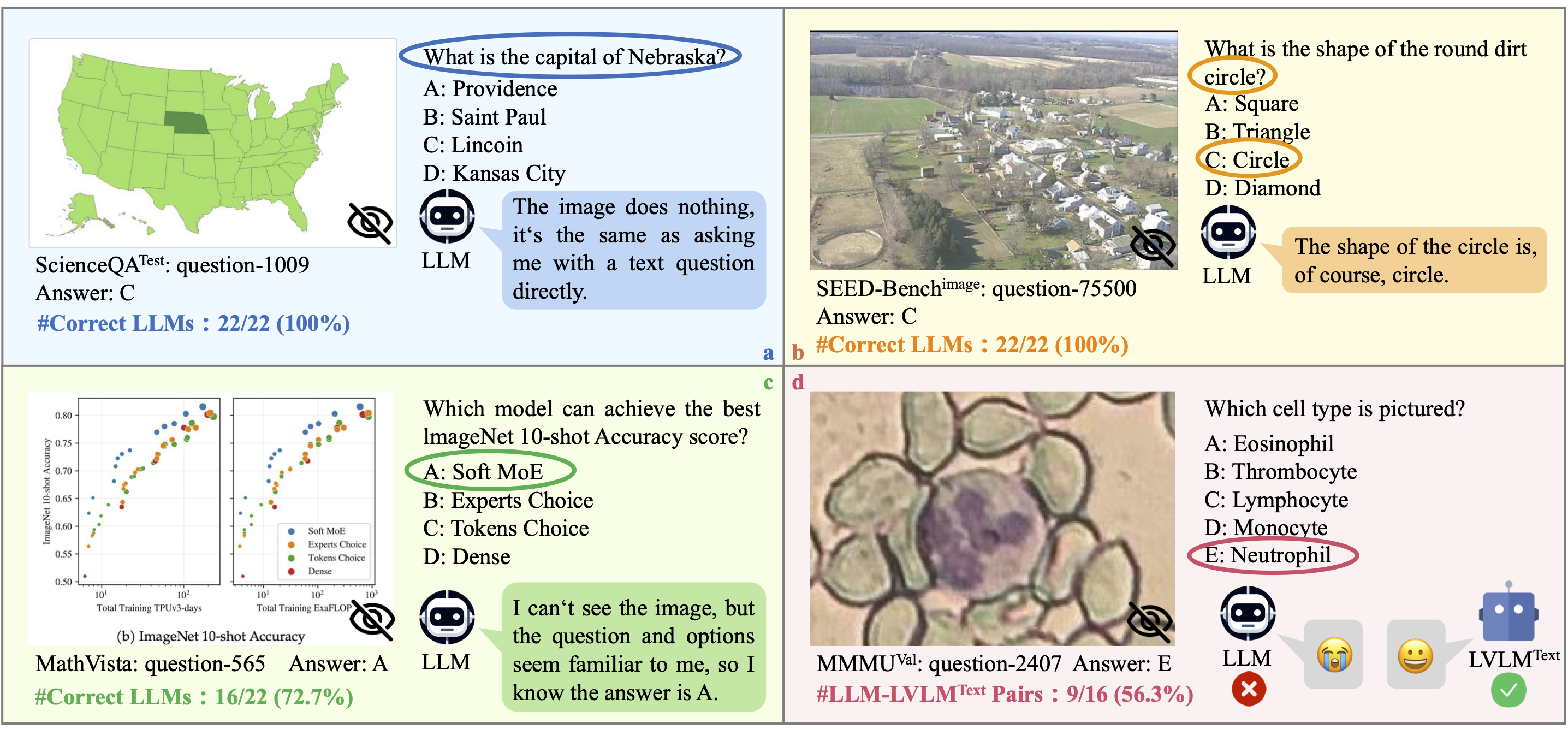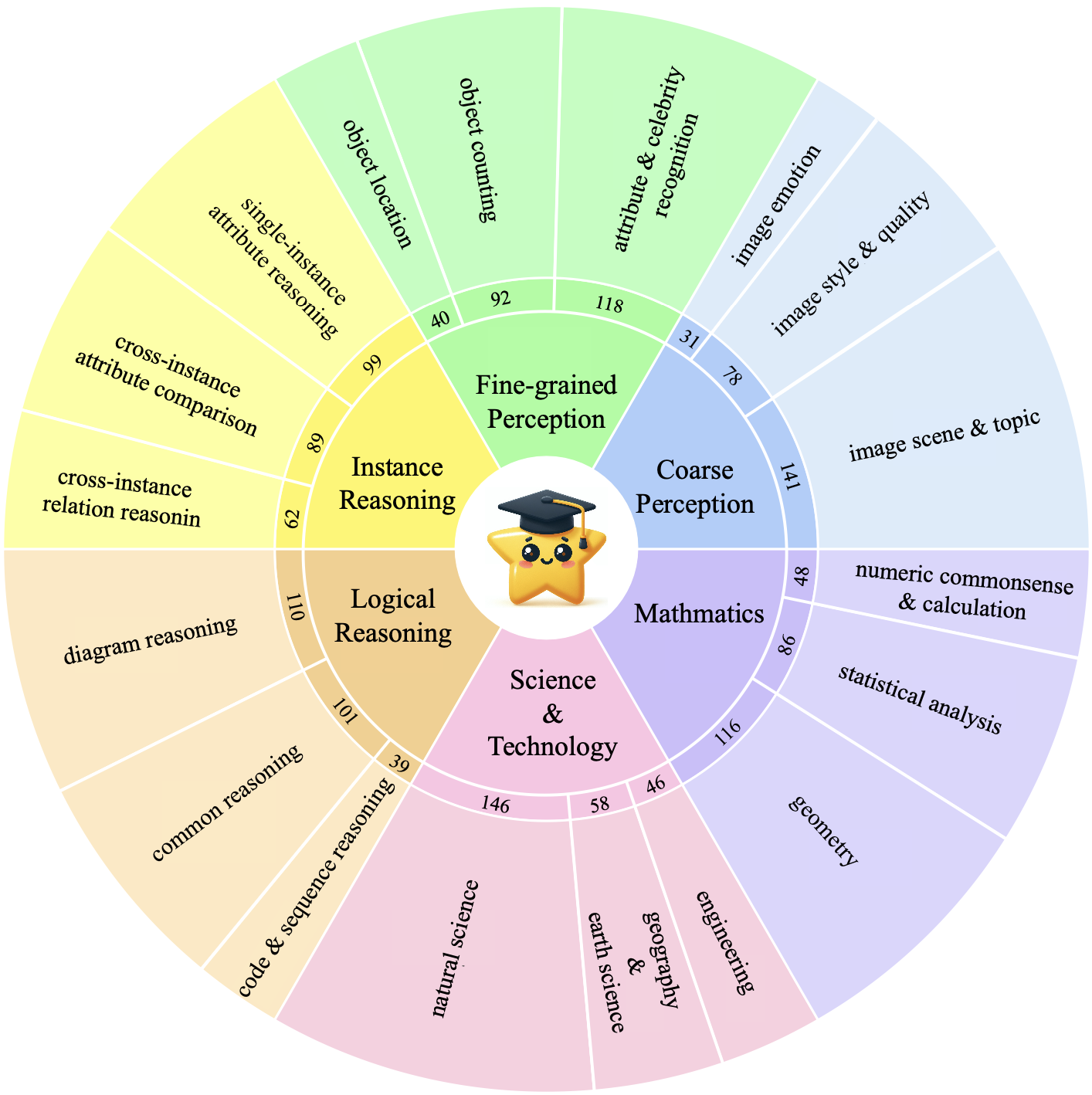task_categories:
- multiple-choice
- question-answering
- visual-question-answering
language:
- en
size_categories:
- 1K<n<10K
configs:
- config_name: val
data_files:
- split: val
path: mmstar.parquet
dataset_info:
- config_name: val
features:
- name: index
dtype: int64
- name: question
dtype: string
- name: image
dtype: image
- name: answer
dtype: string
- name: category
dtype: string
- name: l2_category
dtype: string
- name: meta_info
struct:
- name: source
dtype: string
- name: split
dtype: string
- name: image_path
dtype: string
splits:
- name: val
num_bytes: 44831593
num_examples: 1500
MMStar (Are We on the Right Way for Evaluating Large Vision-Language Models?)
🌐 Homepage | 🤗 Dataset | 🤗 Paper | 📖 arXiv | GitHub
Dataset Details
As shown in the figure below, existing benchmarks lack consideration of the vision dependency of evaluation samples and potential data leakage from LLMs' and LVLMs' training data.

Therefore, we introduce MMStar: an elite vision-indispensible multi-modal benchmark, aiming to ensure each curated sample exhibits visual dependency, minimal data leakage, and requires advanced multi-modal capabilities.
🎯 We have released a full set comprising 1500 offline-evaluating samples. After applying the coarse filter process and manual review, we narrow down from a total of 22,401 samples to 11,607 candidate samples and finally select 1,500 high-quality samples to construct our MMStar benchmark.

In MMStar, we display 6 core capabilities in the inner ring, with 18 detailed axes presented in the outer ring. The middle ring showcases the number of samples for each detailed dimension. Each core capability contains a meticulously balanced 250 samples. We further ensure a relatively even distribution across the 18 detailed axes.

🏆 Mini-Leaderboard
We show a mini-leaderboard here and please find more information in our paper or homepage.
| Model | Acc. | MG ⬆ | ML ⬇ |
|---|---|---|---|
| GPT4V (high) | 57.1 | 43.6 | 1.3 |
| InternLM-Xcomposer2 | 55.4 | 28.1 | 7.5 |
| LLaVA-Next-34B | 52.1 | 29.4 | 2.4 |
| GPT4V (low) | 46.1 | 32.6 | 1.3 |
| InternVL-Chat-v1.2 | 43.7 | 32.6 | 0.0 |
| GeminiPro-Vision | 42.6 | 27.4 | 0.0 |
| Sphinx-X-MoE | 38.9 | 14.8 | 1.0 |
| Monkey-Chat | 38.3 | 13.5 | 17.6 |
| Yi-VL-6B | 37.9 | 15.6 | 0.0 |
| Qwen-VL-Chat | 37.5 | 23.9 | 0.0 |
| Deepseek-VL-7B | 37.1 | 15.7 | 0.0 |
| CogVLM-Chat | 36.5 | 14.9 | 0.0 |
| Yi-VL-34B | 36.1 | 18.8 | 0.0 |
| TinyLLaVA | 36.0 | 16.4 | 7.6 |
| ShareGPT4V-7B | 33.0 | 11.9 | 0.0 |
| LLaVA-1.5-13B | 32.8 | 13.9 | 0.0 |
| LLaVA-1.5-7B | 30.3 | 10.7 | 0.0 |
| Random Choice | 24.6 | - | - |
📧 Contact
✒️ Citation
If you find our work helpful for your research, please consider giving a star ⭐ and citation 📝
@article{chen2024we,
title={Are We on the Right Way for Evaluating Large Vision-Language Models?},
author={Chen, Lin and Li, Jinsong and Dong, Xiaoyi and Zhang, Pan and Zang, Yuhang and Chen, Zehui and Duan, Haodong and Wang, Jiaqi and Qiao, Yu and Lin, Dahua and others},
journal={arXiv preprint arXiv:2403.20330},
year={2024}
}